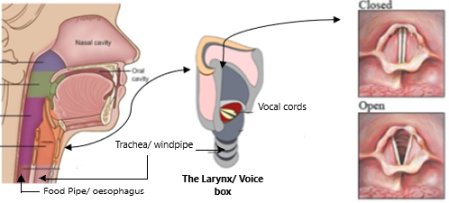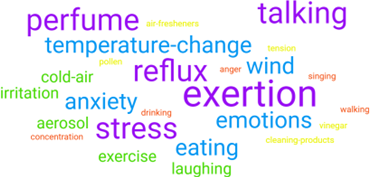This page is designed to provide an explanation of the role of the larynx, laryngeal sensitivity and factors that contribute to laryngeal hypersensitivity.
If you would prefer to have an offline version you can access and save that here.
What is the larynx?

The larynx (aka voice box) is situated behind the Adams apple it is essential for:
Breathing- Air travels through the larynx on the way to the lungs.
Swallowing- The wind-pipe is closed off by the larynx so food/ drink can safely enter the food pipe. Muscles in the throat close when we swallow so food/ drink do not go down ‘the wrong way’.
Coughing- If the larynx senses unwanted material (i.e. food, drink, smoke, etc) entering the airway it will trigger a cough, clashing the vocal cords together to eject unwanted material from the wind-pipe.
Communication- The vocal cords in the larynx vibrate gently to produce sound/ voice.
The tissue along the lining of your voice box is very sensitive. This helps your body detect material that is at risk of entering the airway. The tissue in the voice box needs to be well lubricated with mucus so food can slide into the food pipe and so the vocal cords can vibrate correctly.
What is laryngeal hypersensitivity?
Laryngeal hypersensitivity occurs when the nerves in the larynx become too sensitive, this means they respond to stimulants they usually wouldn’t notice. Examples include:
- A cough in response to cold air or strong smells.
- A constant sensation of mucus in the throat.
- Feeling like your airway is shutting off.
Common Triggers

Disorders associated with laryngeal hypersensitivity
Persistent throat symptoms - the feeling of excessive mucus in the throat, or the feeling of a lump in the throat when there is a normal amount of mucus, and no physical lump.
People sometimes feel that crumbs are left in the throat after eating, even though the food has already passed into the food-pipe.It is quite normal that after swallowing, small amounts of crumbs stay high up in the throat, or sit at the base of the tongue. This is called residue.
People with laryngeal hypersensitivity can become hyper-aware of these crumbs which can feel uncomfortable. The best thing to do is have a sip of water to try and flush these crumbs into the food-pipe, rather than coughing it around the throat.
Inducible laryngeal obstruction - when muscles in the throat close during breathing causing breathlessness and/ or a choking sensation. This is often worse when breathing in.
Chronic cough - an unexplained dry cough lasting more than 8 weeks, often linked to throat irritation. This can occur in coughing ‘bouts’ or ‘fits’.
Dysphonia - Trouble with the voice when trying to talk or sing. This may be described as hoarseness or poor voice quality.
Your speech and language therapist will be able to discuss, diagnose and help you manage these conditions.
Why do I have laryngeal hypersensitivity?
Certain factors can make some people more likely to experience laryngeal hypersensitivity. These can be linked to medical factors, life events and exposure to irritants. It is unclear exactly what causes laryngeal hypersensitivity, however, some key risk factors are:
- Upper airway infections, i.e. colds & flus.
- Dehydration
- Coughing/ throat clearing
- Stress/anxiety
- Medication
- Trauma
- Reflux
- Asthma
- COPD
- Smoking
- Focusing on sensations in the throat
People rarely have only one contributing factor, it is usually a combination of several.
